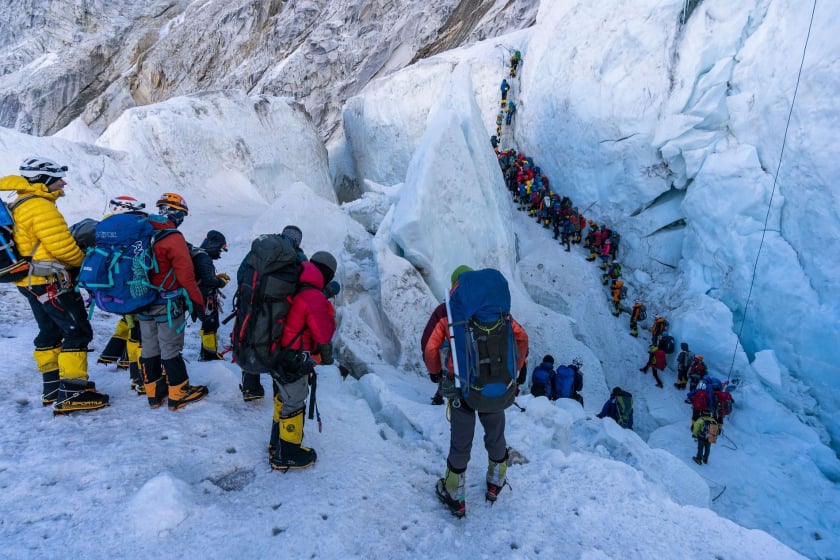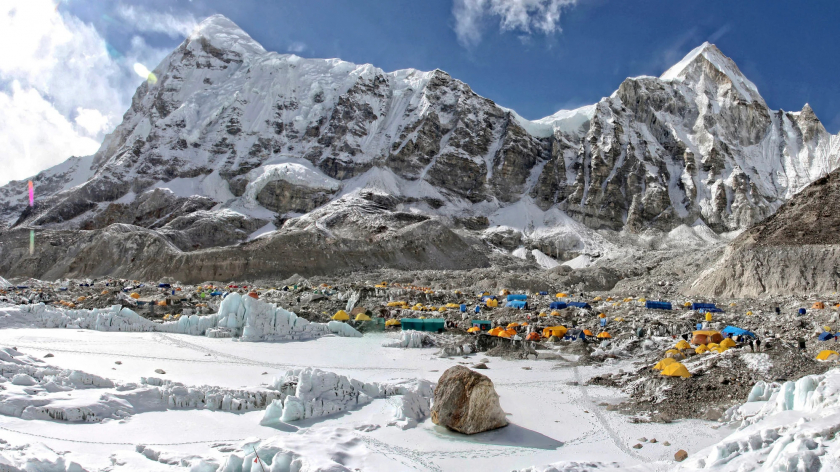Died while conquering Mount Everest in the Himalayas
On May 16, 2022, the first Vietnamese woman to successfully conquer Mount Everest was Nguyen Thi Thanh Nha (Celine Nha Nguyen).
Recently, Thanh Nha shared on her personal Facebook page that Dawa C - the Sherpa leader of the group she was a part of, had passed away. This leader was swept away by an avalanche while clearing the way for his teammates down the mountain and went missing on Manaslu mountain. Helicopters and rescue teams searched the mountain continuously and found Dawa's body swept away by the snow and buried under an ice cliff.
Every year the number of people registering to conquer Mount Everest is increasing. However, the number of people who get injured and stop the expedition, or even lose their lives on the snow-capped mountains is not small.

Trekking to Mount Everest is one of the most spectacular and picturesque treks in the Himalayas.
Mount Everest is located in the Mahalangur Himal massif of the Himalayas. Located on the border of Tibet and Nepal, Mount Everest has an elevation of 8,848.86 m above sea level.
The first two people to conquer Mount Everest were in 1953, two New Zealand explorers Edmund Hillary and Tenzing Norgay - a Nepalese native who acted as a guide. Not only is the mountain very high, but it also has a dangerous and harsh environment. Over the past decade, many people have died every year while conquering this roof of the world.
The oxygen level on Mount Everest is very low, the temperature is extremely cold. People also believe that Everest is only for those who dare to come and do not know if they can survive to return. All participants in the journey to conquer the highest peak in the world must sign a paper to leave their bodies on the mountain. However, despite the expensive expedition tour, this is always a top tourist destination that attracts many people, especially professional climbers who always dream of setting foot on the "roof of the world".

Many people have died while conquering this roof of the world.
According to El País, a Spanish daily newspaper, since 1953, more than 300 climbers have died on the way to the summit of the world's highest mountain. A third of them succumbed to a lack of oxygen that led to their deaths.
Harsh and dangerous, but still many people want to conquer it.
At an altitude of 8,848.86 m, the amount of oxygen surrounding Mount Everest is only 1/3 of that near sea level, which makes it difficult for explorers to breathe due to lack of oxygen because the human body cannot withstand altitudes above 6,000 m. The higher the climb, the less oxygen there is, the body will face many risks including pulmonary edema, cerebral edema and blood vessel blockage.
In addition, frostbite damage increases rapidly because at such high altitudes the heart must work harder to pump blood throughout the body to bring oxygen to the organs. Internal organs are given higher priority, fingers and toes are the last, so when exposed to cold, frostbite occurs, causing people to have to amputate their fingers and toes.
The main causes of death are mostly landslides, falls, altitude sickness and exposure to extreme temperatures...
Max Vu (HCMC), who has had many trips to explore the route at Everest Base Camp, said: “Conquering Everest is definitely one of the most dangerous and harsh routes. Many people have died while conquering this route because of the danger here. The death rate on Everest is very high, so this is considered an obstacle for many people.”

Everest Base Camp is the base camp, the first point in the journey to conquer Mount Everest.
So why is climbing Everest so appealing, despite the high cost and potential risks?
For the community of mountaineers and adventurers, conquering Mount Everest and reaching the "roof of the world" is the desire of many people. For those who have successfully conquered Everest, this event means more than overcoming themselves. Climbing a mountain over 8,000 m high, standing on top of the world and then returning home safely is an unparalleled experience and not everyone can do it.
From landslides, high altitudes to dangerous terrain, snowstorms… all can threaten the lives of climbers at any time. However, perhaps this is the very motivation that makes many people determined to reach this peak.
Mount Everest is the dream of many people, but to see the highest mountain in the world without risking your life, you can take the Everest Base Camp trekking expedition, one of the classic beautiful trekking routes following the footsteps of explorers.
Everest Base Camp is the base camp, the first point in the journey to conquer Mount Everest with an altitude of 5,380 m. This is considered a popular route when climbing mountains in Nepal.
"Everest Base Camp is one of the most classic routes in the world, going below the base camp of climbers to see Everest, this place is both beautiful and suitable for those who come to the Himalayas for the first time. Usually, they will climb the basic route first, then depending on whether the body is suitable to reach that height or not and ensure health, they will gradually increase the level of height. It is recommended to start with the mountains from low to high, for first-time trekkers, they should choose the easy small route in Nepal to be able to see the Himalayas completely", Max Vu shared.
Mount Everest has two main routes, the Tibetan route and the Nepalese route. Of the two main routes, the Nepalese route is technically easier and therefore the more frequently used.
In Nepal it is the Southeast Ridge created by Tenzing Norgay and Edmund Hilary in 1953. From Tibet it is the North Ridge as George Mallory disappeared in 1924 long before a Chinese team conquered the summit in 1960.
Climbing from the southeast, they face a race over the treacherous Khumbu Icefall, but closer to the summit, the climb is shorter and easier to descend in case of emergency. Climbing from the north, it is possible to drive all the way to base camp, but climbers have a long climb to the summit.
The extraordinary Sherpas
Mount Everest is too high and the climate too harsh for anyone to live there, but the valley at its foot is inhabited by Tibetans, known as Sherpas, in villages as high as 4,870 m.
Hundreds of generations of Sherpas living on the plateau have undergone a genetic evolution to adapt to the lack of oxygen. In the towering peaks of the Himalayas, this Nepalese group has become famous for its speed climbing records, pioneering previously unclimbed routes, guiding prowess and extraordinary skills.

Sherpas are hired as porters for climbers on Mount Everest.
Living close to the highest peaks on Earth, the Sherpas consider the Himalayas sacred, building Buddhist monasteries, flying Lungta flags on hilltops and establishing habitats for wild animals such as musk deer and pheasants.
Many Sherpas are employed as porters for climbers on Everest. Although climbing is a viable profession, Sherpas do not attempt to scale climbable mountains, believing them to be the “home of the gods” to which they have great respect.
The mountaineering industry has made them one of the richest peoples in Nepal, yet their mountaineering achievements are often under-recognized by the climbing community and Western media.
The Sherpa's incredible climbing ability, experts speculate, may be partly the result of genetic adaptations to life at high altitudes and in very thin air. And many studies have shown that Sherpas are born with a more favorable genetic mutation that gives them a unique metabolism that allows them to climb high and harsh mountains.


































